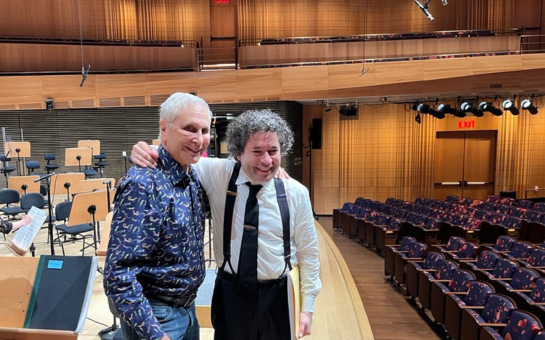- John Corigliano
Triathlon (2020)
- G Schirmer Inc (World)
Commissioned by the San Francisco Symphony with the generous support of Michèle and Larry Corash
- 2(II:pic).2(II:ca).2(II:bcl).2(II:cbn)/4.2.2+btbn.1/timp.3perc/pf.hp/str
- Soprano Saxophone/Alto Saxophone/Baritone Saxophone
- 30 min
Programme Note
Movements
1. Leaps (soprano saxophone)
2. Lines (alto saxophone)
3. Licks (baritone saxophone)
Composer note
The virtuosic possibilities of the soprano sax — rivaling those of the clarinet — inspired a first movement entitled “Leaps” that is buoyant, acrobatic, and optimistic. An orchestral introduction of jumping woodwinds and a long-lined melody leads to the entrance of the soloist who, after a few virtuosic turns, sings the melody introduced by the orchestra. This melody utilizes the entire lyrical range of the soprano saxophone, and leads to a slower section that extends and develops the melody. But the joyous opening returns and the movement ends as it began — with a leap.
The second movement features the alto saxophone, and is entitled “Lines.” Lines, in music, describe the horizontal motion of notes, or, as we know it, melody. And, indeed, this entire movement is totally melodic and serene. The only dynamic climax in it is one of intensity, but it, too, is composed of purely melodic material.
I have always loved the sassy, gravelly sound of the baritone sax, so it had to lead the last movement of my concerto. “Licks” is a jazz term, and means small improvisational moments in a piece. While this is not a jazz movement, the idea of small ornamental turns appealed to me, and provided me with the inspiration for the solo writing.
The movement starts with an unaccompanied cadenza. In it, the soloist explores many of the remarkably unusual sounds that the saxophone family can produce. At the beginning, we hear soft key clicks, which are done without breathing into the instrument. This soon develops into a technique called “slap tonguing,” in which the performer literally slaps his tongue against the reed. It is a totally delightful and rude sound, and both these devices alternate in the body of the cadenza.
After the saxophone plays a giant harmonic glissando, the orchestra enters with a soaring dramatic theme totally at odds with the soloist’s strange sounds. The soloist then enters, playing material with slap-tongue technique, which the orchestra constantly interrupts. Finally, the soloist joins the orchestra in some highly ornamented licks, and the movement barrels forward. The soloist, playing in perpetual motion and in extreme registers, leads us to a central dialogue between him and the woodwinds. The dramatic material returns, building to a climax at which the soloist retrieves his soprano saxophone, and leads the orchestra to its spirited conclusion.
I could not have written this work without the support of a couple whose help in commissioning composers is legendary. This concerto is dedicated to Michèle and Larry Corash, with love and admiration, celebrating their fiftieth wedding anniversary.
— John Corigliano
Scores
More Info

- Dudamel Commences NYPhil Season with Corigliano’s Symphony No. 1
- 15th September 2025
- Gustavo Dudamel, the Music Director Designate of the New York Philharmonic, commences the orchestra’s highly-anticipated season with the Symphony No. 1 by John Corigliano.

- John Corigliano’s Wintertime Premieres and Revivals
- 4th January 2024
- Now in his 85th year, composer John Corigliano continues to produce new scores of striking vibrancy and emotional potency.

 Located in the UK
Located in the UK
 Located in the USA
Located in the USA
 Located in Europe
Located in Europe
